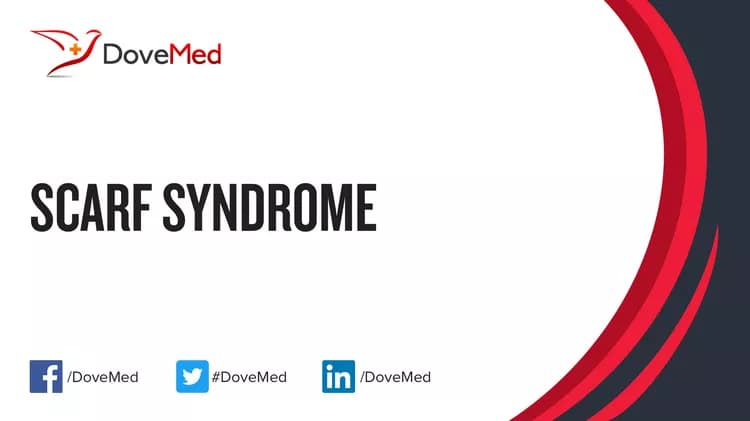What are the other Names for this Condition? (Also known as/Synonyms)
- Skeletal abnormalities, Cutis laxa, craniostenosis, Ambiguous genitalia, Retardation, and Facial abnormalities
What is SCARF Syndrome? (Definition/Background Information)
- SCARF Syndrome is characterized by the association of skeletal abnormalities, cutis laxa, craniostenosis, ambiguous genitalia, psychomotor retardation and facial abnormalities
- So far, it has been described in two males (maternal first cousins)
- The mode of inheritance was suggested to be X-linked recessive
(Source: SCARF syndrome;Orphanet, National Institute of Health and Medical Research (INSERM), Paris.)
Who gets SCARF Syndrome? (Age and Sex Distribution)
- SCARF Syndrome is a rare, congenital disorder. The presentation of symptoms may occur at birth
- The condition predominantly affects males
- Worldwide, individuals of all racial and ethnic groups may be affected
What are the Risk Factors for SCARF Syndrome? (Predisposing Factors)
- A positive family history may be an important risk factor, since SCARF Syndrome is an inherited condition
- Currently, no other risk factors have been clearly identified for SCARF Syndrome
It is important to note that having a risk factor does not mean that one will get the condition. A risk factor increases one’s chances of getting a condition compared to an individual without the risk factors. Some risk factors are more important than others.
Also, not having a risk factor does not mean that an individual will not get the condition. It is always important to discuss the effect of risk factors with your healthcare provider.
What are the Causes of SCARF Syndrome? (Etiology)
- The exact gene mutation that causes SCARF Syndrome is not known at the present time
- SCARF Syndrome is inherited in an X-linked recessive manner
X-linked recessive pattern of inheritance: The gene associated with this condition is located on the X chromosome, which is one of the two sex chromosomes. In males (who have only one X chromosome), one altered copy of the gene in each cell is sufficient to cause the condition. In females (who have two X chromosomes), a mutation would have to occur in both copies of the gene to cause the disorder. Because it is unlikely that females will have two altered copies of this gene, males are affected by X-linked recessive disorders much more frequently than females. A characteristic of X-linked inheritance is that fathers cannot pass X-linked traits to their sons.
What are the Signs and Symptoms of SCARF Syndrome?
The following are some known signs and symptoms of SCARF Syndrome:
(Source: SCARF syndrome;Genetic and Rare Diseases Information Center (GARD) of National Center for Advancing Translational Sciences (NCATS), USA.)
How is SCARF Syndrome Diagnosed?
SCARF Syndrome is diagnosed on the basis of the following information:
- Complete physical examination
- Thorough medical history evaluation
- Assessment of signs and symptoms
- Laboratory tests
- Imaging studies
- Biopsy studies, if necessary
Many clinical conditions may have similar signs and symptoms. Your healthcare provider may perform additional tests to rule out other clinical conditions to arrive at a definitive diagnosis.
What are the possible Complications of SCARF Syndrome?
The complications of SCARF Syndrome may include:
- Congestive heart failure due to cutis laxa
- Lung failure due to cutis laxa
- Signs and symptoms related to a dysfunctional gastrointestinal tract and urinary tract due to cutis laxa
Complications may occur with or without treatment, and in some cases, due to treatment also.
How is SCARF Syndrome Treated?
There is no cure for SCARF Syndrome, since it is a genetic condition. The treatment is usually given to manage the signs and symptoms and any complication that develops
How can SCARF Syndrome be Prevented?
- SCARF Syndrome may not be preventable, since it is a genetic disorder
- If there is a family history of the condition, then genetic counseling will help assess risks, before planning for a child
- Active research is currently being performed to explore the possibilities for treatment and prevention of inherited and acquired genetic disorders
- Regular medical screening at periodic intervals with tests and physical examinations are recommended
What is the Prognosis of SCARF Syndrome? (Outcomes/Resolutions)
- The prognosis of SCARF Syndrome is dependent upon the severity of the signs and symptoms and associated complications, if any
- Individuals with mild conditions have better prognosis than those with severe symptoms and complications
- Typically, the prognosis may be assessed on a case-by-case basis
Additional and Relevant Useful Information for SCARF Syndrome:
Some characteristics of SCARF Syndrome resemble those of Lenz-Majewski hyperostotic dwarfism syndrome.
The following DoveMed website link is a useful resource for additional information:
Related Articles
Test Your Knowledge
Asked by users
Related Centers
Related Specialties
Related Physicians
Related Procedures
Related Resources
Join DoveHubs
and connect with fellow professionals


0 Comments
Please log in to post a comment.